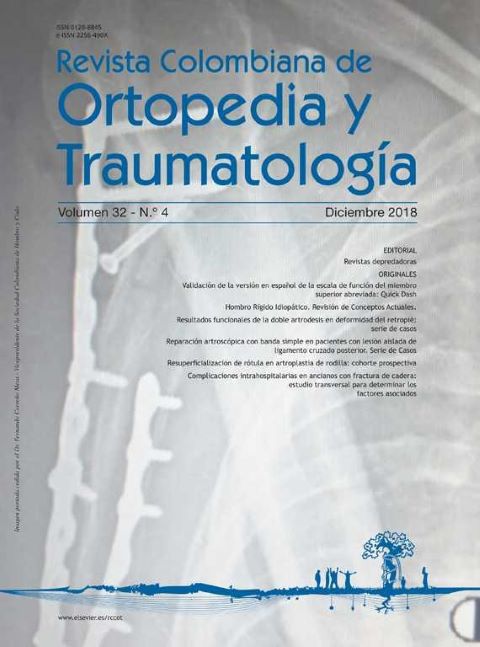Single-row arthroscopic repair in patients with isolated posterior cruciate ligament injury. Case Series
DOI:
https://doi.org/10.1016/j.rccot.2019.02.003Keywords:
posterior cruciate ligament, arthroscopic, surgical results, functional evaluationAbstract
Background: Isolated lesions of the posterior cruciate ligament cause instability and failure in the rotating component of the knee. The objective of this article is to describe the results of single-row arthroscopic treatment using a single-bundle technique with a single tunnel and fixation with interference screws in patients with isolated lesions of the Posterior Cruciate Ligament, grade III.
Methods: A cross-sectional study was conducted using the IKDC Testto evaluate, pre-operatively and yearly, the treatment of posterior cruciate ligament injuries. The statistics used were descriptive, as well as measures of central tendency and dispersion, and Mann Whitney UWilcoxon tests to compare means.
Results: The study included 5 patients, 4 (80%) were male and 1 (20%) female, and a mean age 27.8 years (minimum 20, maximum 33) ± 5.58 years). The affected side was right in 3%, left in 2 (40%) patients, and all showed a posterior drawer sign. The results of the pre-operative IKDC test were: difference of means 2.6, sum of negative ranks 15, sum of positive ranks 0, z = -2.070, P=.038; after surgery no patient had a positive posterior drawer sign.
Discussion: The treatment of isolated grade III lesions of PCL with a single bundle and tunnel technique with an arthroscopic autograft of hamstrings offers good results.
Evidence Level: IV.
Downloads
References
Insall JN, Scott WN. Insall & Scott Rodilla. 3 a . ed. México: Marban; 2010.
López-Vidriero E, Simon DA, Johnson DH. Initial Evaluation of Posterior Cruciate Ligament Injuries: History, Physical Examination. Imaging studies, surgical and non surgical indications. Sports Med Arthrosc Rev. 2010;18:230-7. https://doi.org/10.1097/JSA.0b013e3181fbaf38
Nakagawa S, Johal P, Pinskerova V, Komatsu T, Sosna A, Williams A, et al. The posterior cruciate ligament during flexion of the normal knee. J Bone Joint Surg. [Br]. 2004;86-B:450-6. https://doi.org/10.1302/0301-620X.86B3.14330
Cosgarea AJ, Jay PR. Posterior Cruciate Ligament Injuries: Evaluation and Management. J Am Acad Orthop Surg. 2001;9:297-307. https://doi.org/10.5435/00124635-200109000-00003
Allen CR, Kaplan LD, Fluhme DJ, Harner CD. Posterior Cruciate Ligament Injuries. Curr Opin Rheumatol. 2002;14:142-9. https://doi.org/10.1097/00002281-200203000-00011
Petrigliano FA, McAllister DR. Isolated Posterior Cruciate Ligament Injuries of the knee. Sports Med Arthrosc Rev. 2006;14:206-12. https://doi.org/10.1097/01.jsa.0000212325.23560.d2
McAllister DR, Petrigliano FA. Diagnosis and Treatment of Posterior Cruciate Ligament Injuries. Curr Sports Med Rep. 2007;6:293-9. https://doi.org/10.1007/s11932-007-0065-0
Yang CK, Wu CD, Chih JC, Wei KY, Su CC, Tsuang YH. Surgical Treatment of Avulsion Fracture of the Posterior Cruciate Ligament and Posoperative Management; J Trauma. 2003;54:516-9. https://doi.org/10.1097/01.TA.0000047048.37775.32
Chen CH, Chen WJ, Shih CS. Arthroscopic Reconstruction of the Posterior Cruciate Ligament with Quadruple Harmstring Tendon Graft: A Double Fixation Method. J Trauma. 2002;52:938-45. https://doi.org/10.1097/00005373-200205000-00020
McGinty JB, Burkhart SS, Johnson DH, Jackson RW, Richmond JC. Artroscopía quirúrgica. 5a. ed México: Marban; 2005.
Panchal HB, Sekija JK. Open tibial inlay versus arthoscopic transtibial posterior cruciate ligament reconstruction. Arthroscopy. 2011;27:1289-95. https://doi.org/10.1016/j.arthro.2011.04.007
Palia R, Osti L, Del BuonoA, Denaro V, Maffulli N. Tibial inlay for posterior cruciate ligament reconstruction: a systematic review. Knee. 2010;17:264-9. https://doi.org/10.1016/j.knee.2010.02.006
Afanador-Acuña EW, Sánchez-Villa FJ, Sánchez-Cruz D, Ibanez- ˜ Pinilla M. Resultados funcionales de pacientes con reconstrucción crónica de lesiones aisladas y combinadas del ligamento cruzado posterior. Rev Col Ortop Traumatol. 2016;30:67-76. https://doi.org/10.1016/j.rccot.2016.07.006
Chen CH, Chen WJ, Shih CS. Arthroscopic Reconstruction of the Posterior Cruciate Ligament with Quadruple Harmstring Tendon Graft: A Double Fixation Method. J Trauma. 2002;52:938-45. https://doi.org/10.1097/00005373-200205000-00020
Boutefnouchet T, Bentayeb M, Qadri Q, Ali S. Long-term outcomes following single-bundle transtibial arthroscopic posterior cruciate ligament reconstruction. Int Orthopaedics. (SICOT). 2013;37:337-43. https://doi.org/10.1007/s00264-012-1609-3
Downloads
Published
How to Cite
Issue
Section

| Article metrics | |
|---|---|
| Abstract views | |
| Galley vies | |
| PDF Views | |
| HTML views | |
| Other views | |





